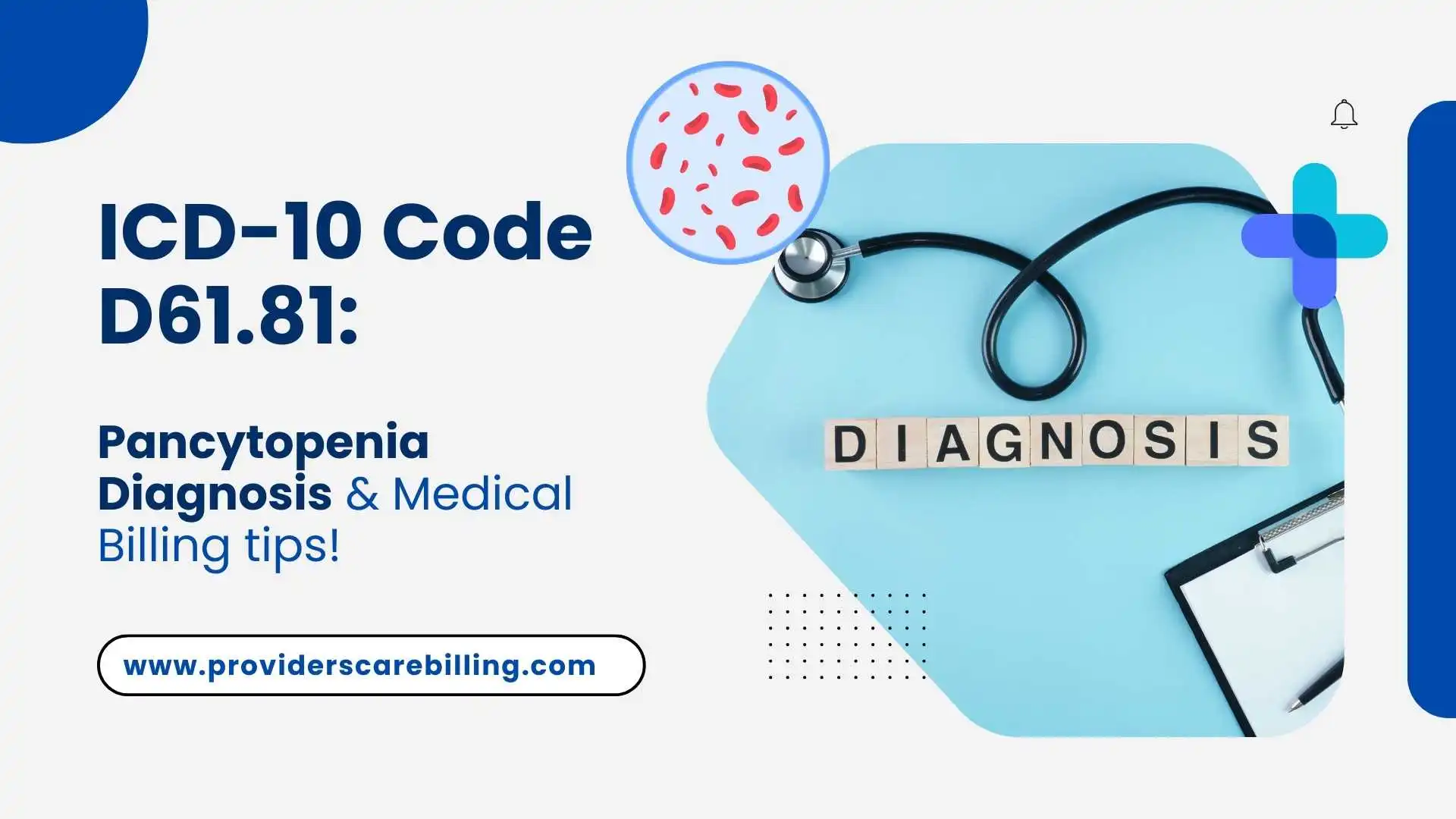Correct coding translates to the proper reimbursement, especially in dealing with pancytopenia and other hematologic disorders.
Pancytopenia —The reduction of the red cell number, white cell, and platelet number is not a disease, but a serious indicator of being ill. Pancytopenia presents an issue both in diagnosis and in the codes, not only due to the severity of chemotherapy side effects but also as a result of bone marrow failure. In the coding world, failure to report this condition in the right manner may result in denied claims and loss of revenue. Find the ICD-10 Code for pancytopenia so that you can work accurately and compliantly and get paid on time, whether you’re in a general hospital, oncology centre, or haematology clinic.
An insightful review of the condition, strategies of ICD-10 coding, and the measures that medical billing firms such as Providers Care Billing LLC can take to help address the denial rates will be explored here.
What do you know about Pancytopenia?
A medical condition defined as the concomitant decrease in the three types of blood cells (red blood cells, white cells, and thrombocytopenia) is known as pancytopenia, often requiring the ICD-10 code D61.81 for documentation. This is a hematologic peculiarity that is not a diagnosis but is usually a sign of underlying pathologies, which may include abnormal levels of red blood cells.
Other Components :
- Inhibition of the bone marrow
- Chemotherapy / Radiation therapy
- Aplastic anemia
- Autoimmune disorders
- Myelodysplastic syndromes
What are the ICD-10 Codes of Pancytopenia?
A medical disorder known as pancytopenia causes a decrease in the total number of blood cells. The following are the common ICD codes used in pancytopenia :
- D61.818 —The main code of reporting pancytopenia is the ICD-10 code D61.818.
- D61.810 —Pancytopenia, a side effect of chemotherapy, significantly alters the red blood cell count.
Such codes are rather common in oncology, hematology, and internal medicine, especially in cases involving red blood cell deficiencies. They not only record the occurrence of pancytopenia, but they also record its etiology in known cases.
ICD-10 Codes Connected with Pancytopenia and Hematologic Disorders
Knowing the associated codes makes it more specific, which raises the chance of clearing claims.
| Condition | ICD-10 Code | Description |
| Chemotherapy-induced Pancytopenia | D61.810 | Chemotherapy-induced pancytopenia in the antineoplastic chemotherapy |
| Pancytopenia | D61.81 | Primary Pancytopenia |
| Bicytopenia | D75.81 | Bicytopenia |
| Cytopenia | D70-D75 | This is based on the line that is involved |
| Unspecified Pancytopenia | D60.818 | Other Pancytopenia |
When pancytopenia is a side effect of antineoplastic treatment, use D61.810.
Case Study
The Texas hematology-oncology clinic charged D61.81 (Pancytopenia) to one of its patients who was receiving chemotherapy. This allegation was rejected since the payer insisted that it had to be specific that this was brought about by chemo, in line with the coding guidelines. The patient’s ICD 10 code was D61.810. Pancytopenia was brought on by antitumor treatment.
ICD-10 Pancytopenia Subtypes that You Ought to Be Aware of
1.D61.81 pancytopenia (General Use)
Applied in case of absence of an additional reason, yet the patient shows decreased levels of WBCs, RBCs, and platelets, which can indicate a need to codify by AAPC using the 2025 ICD-10-CM diagnosis code.
2.D61.810 chemotherapy-induced pancytopenia
Applicable in case of antineoplastic-caused pancytopenia. After uploading to Z51.11 (encounter for antineoplastic chemotherapy) when available.
3.D61.818 Other pancytopenia (not specified)
This is what you resort to when it is not chemo or otherwise specific, particularly when considering the ICD-10 code D61.818.
Mistakes due to Common Coding D61.81
- The application of unspecified codes, such as D61.81, in situations where ethology, such as chemotherapy, will be a documented case.
- Misinterpreting di-bicytopenia (two lineages affected) and pancytopenia (all three lineages affected).
- Pancytopenia is the incorrect term for cytopenia or hypopotassemia (hypopotassemia that has 10 by ICD-10 code E87 and lacks any nucleotides).
Other Considerations for Pancytopenia ICD-10
The other underlying condition is shown by pancytopenia, which can be associated with human immunodeficiency virus infections and may lead to an abnormal decrease in red blood cells. In reviewing by etiology, it may be classified into three categories, namely: impaired production (central type), infiltration/replacement of bone marrow, or increased destruction (peripheral type). Assess the record thoroughly and ask questions where they are needed to ensure accurate coding for other pancytopenia. They are:
- Drug-induced pancytopenia. In cases where the pancytopenia is related to drugs, ICD-10-CM differentiates whether it is caused by antineoplastic chemotherapy (D61.810) or other drugs (D61.811), to which the code is assigned an MCC, which may have an impact on the MS-DRG assignment.
- Where pancytopenia is NOT drug-induced, ICD-10-CM makes it known as other pancytopenia (D61.818), which is a CC and may be a determinant of MS-DRG assignment, particularly in cases of deficiency of each of the three blood types—platelets, white blood cells, and red blood cells. This is accompanied by the condition of pancytopenia that is associated with Acute Myeloid Leukemia (AML) per Coding Clinic.
👉 Need expert help with coding guidelines for pancytopenia ICD-10 claims?
Contact Providers Care Billing LLC — your trusted Medical Billing Company, specializing in complex conditions and high-volume specialties, particularly those involving bone marrow failure syndromes.
📞 Call Now: 888-495-3786
📧 Email: Info@providerscarebilling.com
Tips on Documentation by Coders and Providers on D61.81
- Duplicate the etiology diagnosis wherever applicable or possible- This makes the difference between adding D61.810 and D61.81.
- Combine pair diagnosis with treatment encounters, such as Z51.11, chemotherapy.
- Avoid duplication- Do not combine pancytopenia with each individual cytopenia code if there is no mandate to do so.
- Be on the lookout for drug-induced versions of pancytopenia, which is a medication reaction that can be excluded from oncology treatments.
Proper ICD-10 coding is essential not just for hematologic conditions like pancytopenia, but also for commonly encountered diagnoses such as dehydration. For accurate coding of dehydration in adults and newborns, refer to our guide on ICD-10-CM Codes for Dehydration: E86.0 in Adults & P74.1 in Newborns.
Conclusion
The more adept you are at identifying the correct ICD-10 code, the better your schemes’ reimbursement ratio will be, regardless of whether your pancytopenia appears to be undefined (D61.81), chemotherapy-induced (D61.810), or some other specification (D61.818). Diagnostic errors are a leading cause of a stagnant revenue cycle in your practice (in oncology and hematology, in particular). By teaming up with a team with a track record of expertise in medical billing services, guesswork is done away with, compliance and safety are guaranteed, and better bottom-line figures are secured, ensuring accurate coding with the appropriate ICD-10-CM code.
FAQS
Q: What is the ICD-10 code of pancytopenia caused by chemotherapy?
D61.810- Pancytopenia sustained by antineoplastic chemotherapy.
Q: What will happen when the cause of pancytopenia is unknown?
Apply D61.81 or D61.818 based on notes by the providers. It is preferable to avoid unfixing unless other details make it impossible.
Q: What is the ICD 10 code of pancytopenia unspecified?
D61.81 – Pancytopenia. This term is applied when no definite cause is recorded.




